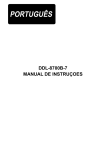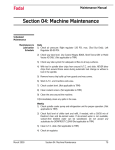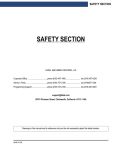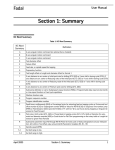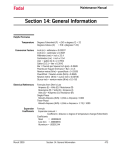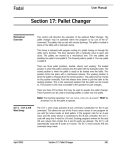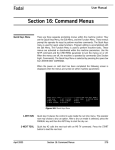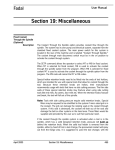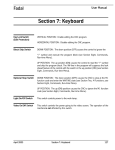Download Touch Probes - Flint Machine Tools, Inc.
Transcript
Fadal User Manual Section 15: Touch Probes Touch Probes Touch Probe Length Offset The tool setting probe is used with the UTILITY command to establish the length offset. It can also be used for tool breakage detection and setting tool diameter offsets. The UTILITY command is used to set diameter and locate the length offset. Enter the command UT and the following menu appears: Figure 15-1 Utility Options Menu Tool Setting Cycle April 2003 The utility command provides two basic functions to aid in the setup procedure. The first function steps the operator through the process of retrieving tools from the turret, entering the diameters and locating the length offsets. Section 15: Touch Probes 339 Fadal User Manual After selecting this cycle the CNC displays the following menu: Figure 15-2 Tool Setting Cycle Menu The information regarding the current tool in the spindle is displayed and the CNC prompts the user for the starting tool number. After entering the first tool number, the CNC responds with the message: Figure 15-3 Starting Tool Number Prompt Respond by entering the last tool number to be set. 340 Section 15: Touch Probes April 2003 Fadal User Manual The following menu appears after the starting and ending tool numbers are defined: Figure 15-4 Tool Setting Options Menu Option 1=Jog to Position This option is used for locating the tool length offset by using the JOG function of the CNC. The CNC prompts the operator to press the JOG key and manually move to the gauge point instead of the automatic process using the probe. Option 2 & 3 - Probe Mount The CNC allows for two probe mounting positions. The left or right orientation is defined as standing in front of the machine, looking Y+ direction. LEFT MOUNT RIGHT MOUNT Y+ X+ Figure 15-5 Probe Mounting Positions Selecting left or right mount determines the X axis shift direction when locating the tool length of an end mill. The left mount probe shifts the X axis in the positive direction before moving Z down. The right mount shifts the X axis in the negative direction before moving Z down. April 2003 Section 15: Touch Probes 341 Fadal Probe Fixture Offset Number (0, 1-48) User Manual Once the probe is installed, a fixture offset can be dedicated to tool setting. The X and Y fixture offset value is the location of the center of the tool setter stylus relative to the HOME position. X AMOUNT Y AMOUNT HOME Figure 15-6 Probe Fixture Offset Number Respond with 0 to ignore this feature or enter the fixture offset number. Probe Offsets Z Fixture Offsets GAGE POINT Z- AMOUNT Z OFFSET Figure 15-7 Z Fixture Offsets 342 Section 15: Touch Probes April 2003 Fadal User Manual After selecting a fixture offset the CNC displays the current X, Y, and Z values and prompts the user with the following message: Figure 15-8 Z Fixture Offset Message Respond by pressing the Y key and begin the process of establishing the Z fixture offset. Then press the N key and the CNC continues the setup procedure using the current Z value. When a fixture offset is selected, the Z fixture offset value is subtracted from the current touch position when determining the length offset. A positive value increases and a negative value shortens the length offset. After selecting a fixture offset, the CNC moves X and Y axes to the fixture offset, loads the first tool, and begins the tool setting process by displaying the following menu: Figure 15-9 Tool Setting Options Menu April 2003 Section 15: Touch Probes 343 Fadal User Manual If the program requires the diameter or the tool is an end mill, the operator selects function 1 and enters the diameter. Select function 2 to begin locating the length offset. Locating Length Using the JOG Function The CNC displays the message: PRESS JOG AND MOVE TO HEIGHT BLOCK OR PRESS MANUAL TO EXIT The operator then presses the JOG key and moves the tool to the desired offset position. When the tool is at the desired location press the MANUAL key. Locating Length Using the Probe Selecting function 2 causes the CNC to move the tool down in one of two ways: 1) If a diameter is entered, the X axis shifts the radius amount, spins the tool backwards, then locates the length. 2) Specifying a zero tool diameter causes the CNC to move the Z down without shifting the X axis or spinning the tool. The CNC performs the following actions for locating the length of an end mill: a. b. c. d. e. f. g. h. i. 344 Spindle ON reverse at 100 RPM X axis is shifted the radius of the tool Z axis down until initial touch Z axis is raised .010" Spindle speed is increased to 500 RPM Z axis down until final touch Spindle off, length offset is stored Z axis returned to COLD START X axis shift position returned Section 15: Touch Probes April 2003 Fadal User Manual After locating the length by either the JOG or PROBE method, the CNC automatically performs a tool change to get the next tool and displays the following menu: Figure 15-10 Tool Setting Options Menu The process is repeated until the last tool has been set. Tool Breakage Detection Tool breakage detection is achieved by a two step process as follows: 1) The CNC is programmed to touch the probe. The tool touch is programmed as a normal program operation except using the G31 P1 code. The G31 is used to stop probe motion. When coded with axis motion, the motion terminates with the probe touch. 2) The L9101 R1+6. code is used to perform the touch check. After performing the touch check, the CNC aborts the program if the tool did not touch, otherwise the program continues. EXAMPLE: Breakage detection for a .25" diameter drill. N1 G0 G90 E24 X0 Y-.5 N2 H2 Z-.1 M65 N3 G1 G31 Y0 F25. P1 N4 L9101 R1+6. April 2003 Section 15: Touch Probes 345 Fadal User Manual Z+ Y+ X0, Y0, E24 X+ .100 CLEARANCE POSITION VIEW Y+ Figure 15-11 Clearance Position & Touch Probe Selection N1 moves X and Y to the clearance position (Left Figure Above). N2 moves the tool .100 below the top of the probe (Right Figure Above) and selects the Touch probe. N3 moves the tool to the center of the probe. Because the block contains the G31 code, the CNC stops moving as soon as the tool touches the probe. The P word used in combination with the G31 causes the CNC to store the touch location. N4 verifies the previous point (P1) has been interrupted by the probe. A broken tool causes the move to go to completion (without a touch) and abort the operation. See PROBE L9101 FUNCTIONS in this section. 346 Section 15: Touch Probes April 2003 Fadal User Manual Touch Probe - Tool Diameter Offset The tool diameter offset is achieved by a two step process as follows: 1) The CNC is programmed to touch the probe at two points. 2) The L9101 R1+8. code is used to perform the calculation. EXAMPLE: After the length offset has been located, the following program is used to establish the diameter of a 1/2" end mill. N1 G0 G90 S500 M4 E24 X0 Y-.5 (.200+.25+.05 N2 H1 Z-.1 M65 N3 G1 G31 Y0 F5. P1 N4 G0 Z.1 N5 Y.5 N6 Z-.1 N7 G1 G31 Y0 P2 N8 L9101 R1+8. R2+.4 D1 N1: The E24 shifts the XY zero to the center and the Z zero to the top of the stylus. The X0 moves to the center of the stylus. The Y-.5 moves to a clearance position, calculated as follows: 1/2 the width of the stylus: .200 1/2 the approximate tool diameter: .250 Clearance: .050 N2: moves the tip of the tool .100" below the top of the stylus while spinning the tool backwards at 500 RPM. N3: moves to touch point 1. N4: moves Z .100 above the stylus. N5: moves to a clearance position in preparation for the next touch. N6: moves Z below the top of the stylus. N7: moves to touch point 2. N8: performs the diameter calculation. April 2003 Section 15: Touch Probes 347 Fadal User Manual The stylus width is specified by R2. The D word specifies the diameter is to be stored as offset 1 in the tool table. General Rules to Follow: MP Series Probe 1) Start the program by selecting the probe. M64 selects the MP Series probe, M65 selects the TS Series probe. 2) A move with the G31 must be a linear (G1) move. 3) No other codes are allowed with the G31 except G1, P# (Point Number), and feed rates. 4) The Probe functions may only use three points for each calculation, P1, P2, and P3. 5) The probing is to be in the absolute mode (G90). 6) CRC, Mirror Image, Rotation and Drill Cycles are not allowed during the execution of the G31 code. Locating the Points There are two procedures available to locate and store the points: 1) Using the G31 P# codes. 2) Using function 1 of the L9101 fixed subroutine. G31 Probe Touch Function The G31 is only used in conjunction with a probe. This code causes the machine to stop motion when the probe is touched and then execution continues at the next line in the program. The G31 can be used with table or spindle probes (See also G31.1). The motion can be defined in absolute or incremental terms. The positions can be stored with a P word, a macro V variable, and output through the RS232 port. All G31 moves must be G1 linear moves. No G0, G2, or G3 moves are allowed. • • • • Rotation can be in effect when the G31 is used. CRC should not be in effect when G31 is used. Mirrored axes should be canceled before using the G31 code. Fixed cycles need to be canceled before using the probe. Note: Program a move that would normally be excessive. For example, if a one inch move is required to get the probe up to a wall, use a two inch move in the program. The probe will stop the motion, and whatever motion is remaining, for that line, will be discarded and the control will continue execution of the program at the next line. 348 Section 15: Touch Probes April 2003 Fadal User Manual Expect some over travel if the feed rate used with the move is high, and also if the stylus in the probe is long. A method for accuracy would be to use the G31 and the G31.1 codes together. Use the G31 at a high feed rate to get up to the wall. With the high feed rate, the stylus is angled and over the edge because of the time required to read the probe and stop the motion. Then reverse the motion to move away from the wall with the G31.1 code in the line. Do this at a slow feed rate. At F1. the motion is slow enough that it will usually stop within one tenth. The G31.1 will stop motion when the probe is not touching. This means that the stylus will be perpendicular to the table and directly at the edge of the wall when the probe is not touching. If the stylus is not running true, or a chip is in the spindle, the probe will not give a true position reading. For consistency use an M19 to orient and lock the spindle at the same position each time the probe inserted in the spindle. If an operator is to place the probe in the spindle by hand, orient the spindle prior to inserting it in the spindle. Sometimes the stylus will work itself loose, confirm that it is tightly screwed in before using the probe. Storing Probed Positions Saving positions through the RS-232 port: 1) Any software designed to save data from the port will be sufficient to retain the data. 2) When a touch is made, the motion will stop and the current position wIll be outputted through the port. G1 G31 X1. F50. This line sends just the X axis location to the port G1 G31 X2. Y5. F50. This line sends the X and Y locations to the port G1 G31 X3. Y-4. Z-2. F50. This line sends the X, Y, and Z locations to the port 3) Macro SPRINT statements can be used just before the probe line to identify the information being saved #SPRINT “PROBE TOUCH #1:” G1 X1. Y1. G31 EXAMPLE: April 2003 Saving Positions to P Words: Section 15: Touch Probes 349 Fadal User Manual 1) P1, P2, and P3 are used to save the touch positions when the fixed probe subroutines are going to be used in the program. G1 X3. Y-6. G31 P1 The first touch position is saved to P1 X0 Y0 G5 G1 X0 Y6. G31 P2 The second touch position is saved to P2 X0 Y0 G5 G1 X-3. Y-6. G31 P3 The third touch position is saved to P3 L9101 R1+2. Use probe fixed subroutine function #2 to find center 2) P1, P2, and P3 can be used with the macro PX1-3, PY1-3, PZ1-3, PA1-3, and PB1-3 variables. When a probe touch (G31) or probe no-touch (G31.1) is used on a line with a P1, P2, or P3 each axis position is stored regardless of the axis that moved to get the touch point. G90 G0 X3. Y-6. Z1. H21 G1 F30. G31 Z-2. F1. Z0 G31.1 P1 P1 has stored the XYZAB position at this line #V1=PZ1 #PRINT “THE TOUCH POINT IS: X”,PX1,", Y",PY1,", AND Z",PZ1 EXAMPLE: Saving the Position as a V Variable: 1) The current position can be saved to a V variable by using a macro AX, AY, AZ, AA, or AB command. G90 G1 X4. Y4. G31 F50. X0 Y0 G31.1 F1. #V1=AX This saves the X position to V1#V2=AY This saves the Y position to V2 G31.1 Probe No Touch Function This code causes the machine to stop motion when the probe is not touching and then execution continues at the next line in the program. The G31.1 can be used with table or spindle probes. This code functions exactly like the G31 code. See also G31. Using G31 During the probing function, the CNC is programmed as normal. Programming a G31 with an axis move causes the CNC to monitor the probe interface and stop all motion in the event of a touch. The CNC stores three touch points in memory. Coding a P1, P2, or P3 in the same block with the G31 designates the touch point to stored. This code also sends the touch or no touch data to the RS-232 serial port. 350 Section 15: Touch Probes April 2003 Fadal User Manual EXAMPLE: G1 G31 F25. X10. P1 Moves the X axis until the probe touches or the move is completed EXAMPLE: If the Probe Touches: The axis motion stops, the X, Y, Z, A, B locations are stored as point 1 and the program continues. EXAMPLE: If the Probe Doesn’t Touch: The CNC stores a value of .100E9 (to signify no touch) as the X location of point #1 and continues the program. The following example shows how to locate three points inside a 3" diameter hole. The approximate center is at X0 and Y0. The Z0 is at the top of the diameter. Y+ 90˚ POINT 1 PUNKT X+ 225˚ PUNKT POINT 2 315˚ PUNKT POINT 3 Figure 15-12 Locating Points N1 M6 T1 (LOAD THE PROBE N2 G0 G90 X0 Y0 (POSITION TO THE APPROX. CENTER N3 Z-.25 H1 M64 (MOVE TIP .25 BELOW TOP OF PART N4 G1 G31 P1 F25. Y1.8 (FIRST POINT N5 F150. Y0 (MOVE OFF PART AND RETURN N6 G31 P2 F25. X-1.273 Y-1.273 (APPROACH AT 225 DEGREES N7 F150. X0 Y0 (MOVE OFF PART AND RETURN N8 G31 P3 F25. X+1.273 Y-1.273 (APPROACH AT 315 DEGREES N9 F150. X0 Y0 (MOVE OFF PART AND RETURN April 2003 Section 15: Touch Probes 351 Fadal User Manual Note: After performing a G31 touch, before another G31 is programmed, the probe must be moved off the part as in N5 and N7 above. L9101 Probe Functions The L9101 fixed subroutine has 10 probe functions available: 1) LOCATE TOUCH POINT 2) CENTER LOCATION AND RADIUS 3) PART ORIENTATION 4) MID-POINT AND ANGLE 5) Z DATUM LOCATION 6) TOOL BREAKAGE DETECTION 7) TOUCH/POSITION CHECK 8) COMPUTE DIAMETER 9) SET PROBE CALIBRATION 10) SET TOUCH POINT The code L9101 is used to call a probe function, the R word R1 selects the specific function. For example: L9101 R1+2. Selects function #2 - CENTER LOCATION AND RADIUS. Upon completion of the L9101, the R words R1-R3 contain the results. The R words can then be used as indirect references throughout the remainder of the program. The touch points are retained in memory until power is removed, thus making it possible to do a mid-program start after the points have been located. As in circular motion, the G17, G18, and G19 modes determine the output of the L9101 subroutine. G17= XY, G18= ZX, and G19= YZ. For example, use function 2 to compute the center location of 3 points. The logical X is returned in R1. When G18 is in effect, R1 contains the physical Z center location. 352 Section 15: Touch Probes April 2003 Fadal User Manual The probing process is designed to be used as a three step process: 1) Locate the points. 2) Use fixed subroutine L9101 to perform the calculations. 3) Continue the program using the R words returned by step 2. Locate Touch Point Function #1: Locates Touch Point Coding: L9101 R1+1. X, Y or Z moves, Approach/Return Feed P1, P2 or P3 define point number Result: Stores Location Specified By P word R1= Logical X Touch, R2= Logical Y Touch Moves to locate a touch point, apply the probe correction and return to the starting position. This function uses a two touch process. The first touch locates the initial point, the second touch is performed at a slow feed rate for best accuracy. EXAMPLE: Example Coding: L9101 R1+1. X1. Y1. F50. P1 Generates the following incremental motion: X1. Y1. F50. G31 G1 (INITIAL TOUCH X.0035 Y.0035 F10. (OVER TRAVEL PROBE SWITCH X-.0707 Y-.0707 F10. G31.1 (MOVES UNTIL NO TOUCH X-.0035 Y-.0035 F10. (MOVES OFF .005 MORE X.0707 Y.0707 F.5 G31 P1 (FINAL TOUCH April 2003 Section 15: Touch Probes 353 Fadal User Manual The following program uses function 1 to locate the 3 points of a circle, instead of G31 as in the previous example. Y+ 90˚ POINT 1 PUNKT X+ 315˚ 225˚ PUNKT POINT 2 POINT 3 PUNKT Figure 15-13 Point Location with Function 1 N1 M6 T1 (LOAD THE PROBE N2 G0 G90 X0 Y0 (POSITION TO APPROX. CENTER X-1. Y-1. F50. G1 (RETURN TO START POSITION N3 Z-.25 H1 M64 (MOVE .25 BELOW TOP OF PART N4 L9101 R1+1. P1 F25. Y1.8 (FIRST POINT N5 L9101 R1+1. P2 F25. X-1.273 Y-1.273 (APPROACH AT 225 DEGREES N6 L9101 R1+1. P3 F25. X+1.273 Y-1.273 (APPROACH AT 315 DEGREES Compute Center and Radius Function #2: Compute Center Location and Radius Coding: L9101 R1+2. Points Used: P1, P2, P3 Results: R1= Logical X, R2= Logical Y, R3= Radius This function computes the center location and radius relative to the three touch points. The X center position is returned in R1, the Y center position returned in R2. and the radius returned in R3. This function may be used with the ID or OD of a circle. The following is a sample program to locate a center 354 Section 15: Touch Probes April 2003 Fadal User Manual and perform a drilling operation at the center of the circle, using the ID of the circle: P1 ? ? P1 P3 P2 P3 P2 Figure 15-14 Circle Center Location N1 M6 T1 (LOAD PROBE N2 G0 G90 X6. Y0. (POSITION TO CENTER N3 Z-.25 H1 M64 (POSITION Z N4 L9101 R1+1. X5. Y1. F25. P1 (LOCATE POINT 1 N5 L9101 R1+1. X5. Y-1. F25. P2 (LOCATE POINT 2 N6 L9101 R1+1. X7. Y-1. F25. P3 (LOCATE POINT 3 N7 L9101 R1+2. (COMPUTE CENTER N8 M6 T2 (LOAD DRILL N9 G0 X+R1 Y+R2 (POSITION TO CENTER N10 H2 Z.1 (BEGIN DRILLING OPERATION N11 G1 F10 Z-2.0 April 2003 Section 15: Touch Probes 355 Fadal Part Orientation User Manual Function #3: Part Orientation Coding: L9101, R1+3., R2= Expected Angle from P2 to P3 Points Used: P1, P2, P3 Results: R1= Logical X, R2= Logical Y, R3= Angular Error ? P3 90˚ P2 P1 Figure 15-15 Intersection Point & Angular Correction This function computes the location of the intersection point and angular correction needed for program rotation. The computed intersection point assumes P1 has a 90 degree relationship to the line created from P2 to P3. 90˚ 0˚ P2 P3 P3 P2 P2 P3 180˚ P3 P2 270˚ Figure 15-16 Expected Angle Changes The expected angle is related to the touch surface. The examples above illustrate how the expected angle changes, depending upon how P2 and P3 touch the part. 356 Section 15: Touch Probes April 2003 Fadal User Manual The angle is coded in decimal degrees, 0 degrees starts at the X+ direction and increases in the counterclockwise direction. PROGRAMMED ANGLE PROGRAMMIERT 90˚ 125˚ ACTUAL ANGLE TATSÄCHLICH P3 P3 P2 P2 Figure 15-17 Programmed Angle P2 to P3 The angular error returned in R3 is the result of subtracting the expected angle from the probed angle (P2 to P3). This angle (R3) becomes the angular correction needed for program coordinate rotation (G68). The sample above shows the programmed angle from P2 to P3 to be 90 degrees. The angle necessary for program rotation would then be 35 degrees if the actual angle is 125 degrees. 1.0 2.0 1.0 2.0 P1 P2 P3 5˚ ROTATION CENTER Figure 15-18 Sample Program to Drill Two Holes in a Part The example above is a sample program to drill two holes in a part. The program XY zero position is approximately the lower left corner of part. The probe stylus is a .25" diameter. April 2003 Section 15: Touch Probes 357 Fadal User Manual N1 M6 T1(LOAD PROBE N2 G0 X-.5 Y1. (CLEARANCE POSITION FOR POINT 1 N3 Z-1.0 H1 M64 N4 L9101 R1+1. X.5 F25. P1 (MOVE TO TOUCH POINT 1 N5 Z0 G0 N6 X1.0 Y-.5 (CLEARANCE POSITION FOR POINT 2 N7 Z-1.0 N8 L9101 R1+1. Y.5 F25. P2 (MOVE TO TOUCH POINT 2 N9 G0 Z-1.0 N10 X5.0 Y-.5 (CLEARANCE POSITION FOR POINT 3 N11 Z-1.0 N12 L9101 R1+1. Y.5 F25. P3 (MOVE TO TOUCH POINT 3 N13 L9101 R1+3. R2+0 (CALCULATE PART ORIENTATION N14 G90 G0 H0 Z0 N15 M6 T2 (LOAD DRILL N16 G90 G0 X+R1 Y+R2 S10000 M3 (MOVE TO INTERSECTION POINT N17 G92 X0 Y0 (SET ABSOLUTE LOCATION N18 G68 R0+R3 X0 Y0 (SET ROTATION N19 Z.1 H1 M8 N20 G81 G99 Z-1.0 R0+.05 F50. X1.125 Y1.125 (DRILL CYCLE N21 X3.125 (DRILL SECOND HOLE N22 G69 G80 .125 .125 X+R1 Y+R2 Figure 15-19 CNC Movement to Corner After probing the part and establishing the rotation, programming X.125 Y.125 causes the CNC to move the center of the tool to the corner of the part. 358 Section 15: Touch Probes April 2003 Fadal Mid-Point and Angle User Manual Function #4: Mid-Point and Angle Coding: L9101, R1+4., R2= Expected Angle Points Used: P1, P2 Results: R1= Logical X, R2= Logical Y, R3= Angular Error ? P2 P1 Figure 15-20 Mid-Point and Angle This function computes the location of the point between P1 and P2 and the angular correction needed for program rotation. The angular error is determined the same as function 3 - PART ORIENTATION previously described. The following are two examples using this function: P2 P1 Figure 15-21 Part with Unknown Rotation April 2003 Section 15: Touch Probes 359 Fadal User Manual The example above shows a part having an unknown rotation. After using this function, the R3 contains the angular correction needed for rotation. UNKNOWN P1 P2 1/2 Figure 15-22 Part with Unknown Width The example above shows a part having an unknown width. After using this function, the R1 contains the location of the midpoint. Z Datum Location Function #5: Z Datum Location Coding: L9101, R1+5., Optional Z Modifier Points Used: P1 Results: R1= Distance From Length Offset Position To Z Datum PROBE STYLUS UNKNOWN UNBEKANNT KNOWN BEKANNT PART FIXTURE Figure 15-23 Z Datum Location 360 Section 15: Touch Probes April 2003 Fadal User Manual This function is used to calculate the distance between an unknown surface and the gauge point (Tool Length Offset Position). The procedure is as follows: 1) Setup: A length offset is set for the probe as a normal tool. 2) Programming: a. b. c. d. The probe is moved to the gauge point using the H word. The Z touch for P1 is found using G31 or function 1 of L9101. Function 5 is used to calculate the distance. The R1 is referenced as the distance to the surface. The following example shows how to locate the top surface and remove .010": N1 M6 T1 (LOAD PROBE N2 H1 M64 (MOVE TO OFFSET, SELECT MP8 PROBE N3 G1 G31 F25. Z-30. P1 (LOCATE P1 N4 L9101 R1+5. Z-.010 (CALCULATE, ADD -.01 N5 M6 T2 (LOAD END MILL N6 M3 S10000 (SPINDLE ON N7 Z+R1 H2 (POSITION Z N8 G1 F100. X10. (MACHINE .010 OFF TOP Block 7 above positions the Z axis .01 below the touch position. Another method available is to use the G92 preset code as follows: N6 M3 S10000 (SPINDLE ON N7 H2 (POSITION Z N8 G92 Z-R1 (PRESET ABS. Z LOCATION N9 Z0 N10 G1 F100. X10. (MACHINE .010 OFF TOP Using the G92 code allows the absolute Z location to be relative to the touch position for the remainder of the program. When machining multiple parts, the Z datum can be stored as a fixture offset using G10 L02 Z-R1 P#. April 2003 Section 15: Touch Probes 361 Fadal Tool Breakage Detection User Manual Function #6: Tool Breakage Detection Coding: L9101, R1+6. Points Used: P1 Results: A No Touch Causes The CNC Program To Stop CONTACT KONTAKT NO CONTACT KEIN KONTAKT Figure 15-24 Tool Breakage Detection This function is used to check if P1 had a successful Y or Z touch position stored. A block containing a G31, P1 with a move that doesn’t touch the tool setting probe causes the CNC to store a value to signify a touch was not made. See “USING THE TOUCH PROBE - TOOL BREAKAGE DETECTION” previously described. Touch Check, Position Check Function #7: Touch Check, Position Check Coding: Touch Check: L9101, R1+7., R2= False #, R3= True # Position Check: L9101, R1+7., R2= False #, R3= True # R4= Approach Direction, X, Y, Z, A or B # Points Used: P1 Results: R2= True # or False # 362 Section 15: Touch Probes April 2003 Fadal User Manual The following diagram describes this function: Figure 15-25 Touch Check, Position Check An X, Y, Z, A, or B dimension word included with the L9101 block is used for the position check. Motion will not occur; the CNC uses the axis word only for the position check. The R4 indicates approach direction; R4+1.= Positive, R41.= Negative. EXAMPLE: L9101 R1+7. R2+10. R3+20. R4-1. Y-2.5 1) Approaching negative with a touch at Y-3.0 returns R2 with a value of 20. 2) Approaching negative with a touch at Y+1.0 returns R2 with a value of 10. April 2003 Section 15: Touch Probes 363 Fadal True or False Comparison User Manual Function #7: Continued Coding: Touch Check: L9101, R1+7., R2= False #, R3= True # Position Check: L9101, R1+7., R2= False #, R3= True # R4= Approach Direction, X, Y, Z, A or B # Points Used: P1 Results: R2=True # or False # Using the True/False response to redirect the program allows for numerous capabilities. The following is an example how the program operation changes according to the touch position: ENDE TOUCH POINT AFTER BERÜHRUNG NACH 5" Y 5.0" P1 POSITIVE APPROACH DIRECTION ANNÄHERUNG POSITIV FINISH TOUCH POINT AFTER BERÜHRUNG NACH 5" Y 5.0" Y P1 POSITIVE APPROACH DIRECTION ANNÄHERUNG POSITIV X Figure 15-26 True/False Comparison N1 M6 T1 (LOAD PROBE N2 G0 G90 X0 Y0 (POSITION XY N3 Z-1.0 H2 M64 (POSITION Z, SELECT MP8 N4 G1 G31 Y10. F25. P1 (MOVE TO TOUCH N5 L9101 Y5.0 R1+7. R2+8. R3+11. R4+1. (COMPARE POSITION N6 M6 T2 (LOAD TOOL N7 M99 P+R2 (“AT” or “PAST”= N11,BEFORE = N8 G10 L12 P2 R0+.55 (SET DIAMETER FOR ROUGHING N9 F25.0 (SET ROUGHING FEED RATE N10 M98 P1 (CALL SUB. TO MACHINE PART N11 G10 L12 P2 R0+.5 (SET DIAMETER FOR FINISHING N12 F50.0 (SET FINISH FEED RATE N13 M98 P1 (CALL SUB. TO MACHINE PART 364 Section 15: Touch Probes April 2003 Fadal User Manual This example finds a touch point and begins the finishing operation at N11 when the Y touch position is “AT” or “PAST” the Y+5", otherwise the roughing operation is performed. Calculate Diameter Function #8: Calculate Diameter Coding: L9101, R1+8., R2= Stylus Width D#= Offset Number (Optional) Points Used: “Y” of P1 and “Y” of P2 Results: R1= Tool Diameter/Radius Logical X of P1= Tool Diameter/Radius This function performs the diameter/radius calculation. The value returned depends on the selection made using the SETP command. When the machine is in the DIAMETER mode the result is diameter, otherwise radius is returned. Specifying a D word in the block with L9101 causes the CNC to store the value in the tool offset table. The X of P1 contains the result of the calculation. This enables function 7 to perform a Position Check. See USING THE TOUCH PROBE - TOOL DIAMETER OFFSET previously described. Set Calibration Function #9: Set Probe Calibration Coding: L9101, R1+9., R2= Radial Over travel X, Y or Z= Shift Amount Points Used: None Results: Used With Function #1 This function establishes the probe compensation. The L9101 Function 1 uses these values when present for error correction. In most cases this function is not needed because most tolerances are greater than the probe errors. XY Shift Error The shift error is the difference between the center of the spindle and the center of the probe. The probe has an adjustment to align the centers. The CNC XY shift capability allows another method to compensate for the error. Radial Over Travel Before the probe indicates a touch, the stylus must touch the surface and open the contacts inside the probe. This causes a slight over travel error. This probe error varies with the length of the stylus. For example, an over travel error of approximately .0012" occurs with a 2" stylus length. The error increases to .0043" with a 7" stylus length. Applying over travel correction improves the 2" stylus error to +-.0004" and the 7" stylus error to +-.0012. April 2003 Section 15: Touch Probes 365 Fadal User Manual When locating the center of a circle, the over travel of the probe doesn’t change the computed center location. The radius of the circle appears larger when inside a hole and smaller when outside a boss. MP8 Probe Calibration 1) Mount an inspection ring on the table. 2) Set the XY home position at the center of the ring. 3) Install the probe and run the following program: N1 M64 G1 G90 Z-??(MOVE Z INSIDE RING N2 L9101 R1+1. Y5.0 F25. P1 N3 L9101 R1+1. X-4.33 Y-2.5 F25. P2(TOUCH 120 DEG. APART N4 L9101 R1+1. X+4.33 Y-2.5 F25. P3 N5 L9101 R1+2.(COMPUTE CENTER 4) Enter the command; SUM Function #9: Continued Coding: L9101, R1+9., R2= Radial Over Travel X, Y or Z= Shift Amount Points Used: None Results: Used With Function #1 After entering the SUM command the CNC displays the point data, R words, points used and the probe correction setting as follows: P1=0,0,0,0,0,0,0,0,0 P2=0,0,0,0,0,0,0,0,0 P3=0,0,0,0,0,0,0,0,0 R WORDS R0-R9 0,0,0,0,0,0,0,0,0,0 POINTS USED X Y The point values are displayed in the axis order of P1=X, Y, Z, U, V, W, A, B, C. The R values are displayed in ascending numerical as R0, R1, R2, R3, R4, R5, R6, R7, R8, R9. Entering XY Shift Values 366 The negative values of R1 and R2 are used for the shift values. R1 becomes the X shift and R2 becomes the Y shift. Section 15: Touch Probes April 2003 Fadal User Manual EXAMPLE: The probe indicates the center location to be at X.001 and Y.002 after performing the calibration. The compensation is entered as L9101 R1+9.R2+ X-.001 Y-.002 Entering Radial Over Travel After the ring gauge test, R2 contains the effective radius. The amount entered for compensation is computed by subtracting the effective radius from the apparent radius. EXAMPLE: Ring Gauge Radius= 1.500" Stylus Radius= .125" Apparent Radius= 1.375" Effective Radius= 1.378 1.375 - 1.378 = -.003 (Correction Needed) The XY shift and radial correction is entered as: L9101 R1+9. R2-.003 X-.001 Y-.002 The correction is entered in the program before L9101 function 1 is used. Set Counter Function #10: Set Counter Coding: L9101, R1+10., P1= Increments the counter by 1 X = Sets the counter starting number Points Used: None Results: Used With Function #7 to create IF - Then statement This function is used to create an IF - Then statement for program redirection. The examples below use this function to perform G52 program shifts for multiple part programming. % N1O101 (SUB FOR PART MACHINING N2G1G90F250. N4X1. N5Y1. N6X0 N7Y0 N8M99 N1O9110 (IF THEN PROGRAM REDIRECTION EXAMPLE N2L100 (SUB TO SHIFT THEN MOVE N3G52X+R8Y+R7 (LOCAL COORDINATE SYSTEM N4M98P101 (INPUT SUB PROGRAM NUMBER N5M17 N6M30 N7R9+0R8+0R7+0 (ASSIGN R VARIABLES N8L101 April 2003 Section 15: Touch Probes 367 Fadal User Manual N9G91G10L109P1 (INCREMENT X COUNT BY +1 N10G90 N11G91G10L108P2 (INCREMENT X STEP BY +2 N12G90 N13L9101R1+10.X+R9P1 (SETS THE X VALUE TO COUNT N14L9101R1+7.X3.R2+24.R3+16.R4+1. (IF COUNT IS X OR HIGHER N15M99P+R2 (GOTO R3 ELSE GOTO R2 N16G91G10L107P-2 (INCREMENT Y STEP BY -2 N17G90 N18L9101R1+10.Y+R7P1 (SETS THE Y VALUE TO COUNT N19L9101R1+7.Y-5.R2+21.R3+25.R4-1. (IF COUNT IS Y OR HIGHER N20M99P+R2 (GOTO R2 ELSE GOTO R3 N21R8+0 (ASSIGN VARIABLES N22G52X0Y+R7 (MOVE TO X0 Y(R7 VALUE) N23R9+0 (ASSIGN R VARIABLE N24M99P8 (GOTO LINE #8 N25M5M9 N26M2 Set Touch Point Function #10: Set Touch Point Coding: L9101, R1+10.,X, Y, Z, P X, Y, AND Z = Location of point Points Used: None Results: The P word identified by the X, Y, and Z location is used with other L9101 functions. This function may be used to identify the centers of two bores and calculate the center and angle between them. The example below locates the center of two bores and calculates the center and angle between them. N1 M6 T1 (LOAD PROBE N2 G0 G90 X6. Y0. (POSITION TO CENTER OF THE FIRST BORE N3 Z-.25 H1 M64 (POSITION Z N4 L9101 R1+1. X6. Y1. F25. P1 (LOCATE POINT 1 N5 L9101 R1+1. X4. Y-1. F25. P2 (LOCATE POINT 2 N6 L9101 R1+1. X8. Y-1. F25. P3 (LOCATE POINT 3 N7 L9101 R1+2. (COMPUTE CENTER OF THE FIRST BORE N8 R9+R1 R8+R2 (RENAME THE LOCATION N9 G0 G90 X10. Y0 (POSITION TO CENTER OF THE SECOND BORE N10 L9101 R1+1. X10. Y1. F25. P1 (LOCATE POINT 1 368 Section 15: Touch Probes April 2003 Fadal User Manual N11 L9101 R1+1. X8. Y-1. F25. P2 (LOCATE POINT 2 N12 L9101 R1+1. X12. Y-1.F25. P3 (LOCATE POINT 3 N13 L9101 R1+2. (COMPUTE CENTER OF THE SECOND BORE N14 R7+R1 R6+R2 (RENAME THE LOCATION N15 L9101 R1+10. X+R7 Y+R6 P2 (SET THE CENTER OF THE SECOND BORE TO POINT 2 N16 L9101 R1+10. X+R9 Y+R8 P1 (SET THE CENTER OF THE FIRST BORE TO POINT 1 N17 L9101 R1+4.R2+0 (COMPUTE CENTER AND ANGLE OF THE TWO BORES N18 G90 G10 L2 P1 X+R1 Y+R2 (SET THE CENTER OF THE BORES AS FIXTURE OFFSET 1 N19 G0 G90 E1 X0 Y0 (MOVE TO FIXTURE 1 ZERO N20 G68 X0 Y0 R0+R3 (SET ROTATION WITH THE ANGLE OF THE BORES Probe Tutorial Examples in Format 2 Always test the probe to determine if it is functioning properly by typing the M64 M66 code in MDI. Then go into jog, touch the stylus, and look for the touch/no touch message. The stylus should run true when the probe is rotated by hand. Place an indicator in a magnetic base and put the indicator tip on the end of the stylus. Rotate the probe head by hand and observe the run out. Use the adjustment screws to get the stylus to run true. 1) This example will demonstrate how the G31 code stops motion and allows the control to move to the next line in the program. The move on the line with the G31 or the G31.1 is usually a move that is beyond the desired touch point. EXAMPLE: G91 G1 F50. M64 M66 X-3. G31 M0 Look at the X axis position at this point X1. G0 M99 P1 Start by jogging the probe to approximately one inch to the right side of a solid object. The end of the stylus should be below the top of the solid object. 2) This example will demonstrate the effect of feed rate on over travel after the probe indicates to the control that a touch has been made. April 2003 Section 15: Touch Probes 369 Fadal User Manual EXAMPLE: G91 G1 F50. M64 M66 X-3. G31 M0 X1. G0 M99 P1 Start by jogging the probe to approximately one inch to the right side of a solid object. The position display will present the current X axis location. Press the START button to run this routine each time the position is displayed. Notice that the location changes over several times it is run. Next, change the feed rate on line one. Make it faster, then try it at slower feed rates. The position should repeat more consistently at the slower feed rates. The faster the feed rate, the further the machine will over travel at the touch point. 3) This example will demonstrate a two-touch method of finding a point on an edge. EXAMPLE: G91 G1 F50. M64 M66 X-3. G31 X.05 F1. X-3. G31 M0 X1.G0 M99 P1 Start by jogging the probe to approximately one inch to the right side of a solid object. The end of the stylus should be below the top of the solid object. The first touch is at a high feed rate and is only used to get the stylus in the general area of the edge. Then the stylus moves away and the second approach is used to get a “good” point. From the second example it was demonstrated that the slower feed rate results in a more consistent touch position. 4) This example will demonstrate the use of the G31.1 code. The G31 code will stop motion when the probe switch is opened. The G31.1 code will stop motion when the probe switch is closed. The G31.1 code is used just after a G31 code is used. The probe switch is opened when the stylus touches an edge and the motion continues to cause the stylus to open the switch. At this point, the stylus should be at an angle. It should be mentioned 370 Section 15: Touch Probes April 2003 Fadal User Manual that the longer the stylus, the more over travel will be required to open the switch. Motion in the opposite direction can now be stopped with a G31.1 code. When the stylus is vertical, the probe switch is now closed and the motion will stop because of the G31.1 code. EXAMPLE: G91 G1 F50. M64 M66 X-3. G31 F10. X1. G31.1 M0 X1. G0 M99 P1 Try to vary the second feed rate. Again observe the X axis position. The slower feed rate will result in a more consistent final position. 5) This is a variation on the fourth example. Start by jogging the probe to approximately one inch to the right side of a solid object. The end of the stylus should be below the top of the solid object. EXAMPLE: G91 G1 F50. M64 M66 X-3. G31 X1. G31.1 F.5 X-3. G31 M0 X1. G0 M99 P1 Notice the amount of time required to pick up a point with each of these methods. Compare the time from examples 4 and 5. Also compare the positions picked up using each method. Consistency and time should be issues to be aware of. Using the Probe with Macro Statements Examples in Format 2 April 2003 Always test the probe to determine if it is functioning properly by typing the M64 M66 code in MDI. Then go into jog, touch the stylus, and look for the touch/no touch message. Section 15: Touch Probes 371 Fadal User Manual The stylus should run true when the probe is rotated by hand. Place an indicator in a magnetic base and put the indicator tip on the end of the stylus. Rotate the probe head by hand and observe the run out. Use the adjustment screws to get the stylus to run true. Macro statements can be used to make determinations from the positions picked up with the probe. 1) Use the AX, AY, AZ, AA, and AB macro statement to collect and use the current axis position. Start by jogging the probe to approximately one inch to the right side of a solid object. The end of a stylus should be below the top of the solid object. EXAMPLE: G91 G1 F50. M64 M66 X-3.G31 X1. G31.1 F.5 X-3.G31 #V1=AX M0 X1. G0 M99 P1 The macro statement states, “Make the V1 variable equal to the current X axis location (AX). To see this value in memory, use the DV command from the command mode. The current location will be stored in the V1 variable location on the screen. These examples can all be used for the other axes, and they could all be used in absolute as well. 2) This example will demonstrate how to use a macro statement to determine the center point of the part. Start by placing a 1-2-3 block in a vice. hold the block with the three inch sides in the jaws. Jog the probe to approximately one inch to the right side of the block. The end of the stylus should be approximately .25 below the top of the block. EXAMPLE: 372 G91 G1 F50. M64 M66 X-3. G31 X1. G31.1 F.5 Section 15: Touch Probes April 2003 Fadal User Manual X-3. G31 #V1=AX Z1. G0 X-4. Z-1. F50. X3. G31 X-3. G31.1 F.5 X3. G31 #V2=AX #V3=(V1+V2)/2 Z1. G0 X4. Z-1. M0 M99 P1 The V1 variable represents the right side touch; the V2 variable represents the left side touch point. The V3 variable represents the mid-point of the block. This mid-point will be relative to the SETX position. View the V3 value in the variable table by using the DV command in the command mode. 3) This example will demonstrate the ability to alter or establish a fixture offset using the probe and a macro statement. Start by placing a 1-2-3 block in a vice. Hold the block with the three inch sides in the jaws. Jog the probe to approximately one inch to the right side of the block. The end of the stylus should be approximately .25 below the top of the block. EXAMPLE: April 2003 G91 G1 F50. M64 M66 X-3. G31 X1. G31.1 F.5 X-3. G31 #V1=AX Z1. G0 X-4. Z-1. F50. X3. G31 Section 15: Touch Probes 373 Fadal User Manual #V2=AX #V3=(V1+V2)/2 #FX1=V3 Z1. G0 X4. Z-1. M0 M99 P1 The V1 variable represents the right side touch; the V2 variable represents the left side touch point. The V3 variable represents the mid-point of the block. This mid-point will be relative to the SETX position. The FX1 macro statement is used to enter the value of V3, which is the mid-point position, into the X value of fixture offset 1. Use the DF command and the DV command to compare the values in the fixture table and the variable table. 374 Section 15: Touch Probes April 2003 Fadal User Manual Fixed Subroutines Examples in Format 2 Always test the probe to determine if it is functioning properly by typing the M64 M66 code in MDI. Then go into jog, touch the stylus, and look for the touch/no touch message. The stylus should run true when the probe is rotated by hand. Place an indicator in a magnetic base and put the indicator tip on the end of the stylus. Rotate the probe head by hand and observe the run out. Use the adjustment screws to get the stylus to run true.The control has fixed subroutines specially designed to work with the probe. This section will discuss the use of these routines. 1) Each subroutine requires that the positions used in the calculations are stored in P variables. There are two methods to pick up and store P values: EXAMPLE: Method 1 The P1, P2, or P3 variables will store the values of the moving axes in the line with the G31 or G31.1 codes. G91 G1 F50. M64 M66 X-3. G31 P1 M0 X1. G0 M99 P1 The P1 on the line with the G31 will store the X value of the touch point G91 G1 F50. M64 M66 X-3. G31.1 P1 M0 X1. G0 M99 P1 The P1 on the line with the G31.1 will store the X value of the touch point G91 G1 F50. M64 M66 Z-5. G31 P1 M0 X1.G0 M99 P1 The P1 on the line with the G31 will store the Z value of the touch point April 2003 Section 15: Touch Probes 375 Fadal User Manual G91 G1 F50. M64 M66 X-3. Y-3. G31 P1 M0 X1. G0 M99 P1 The P1 on the line with the G31 will store the X and Y axis values Method 2 Use the L9101 subroutine function 1 to move and store the point. Note that the program must be written in absolute terms. When using the example use the SETX command to set the X axis home approximately one inch to the right of the object to touch. EXAMPLE: G90 G1 M64 M66 L9101 R0+1. X-3 F25. P1 M0 X1. G0 M99 P1 The function for the L9101 subroutine is selected with the R0+1. selects function 1 of the L9101 subroutine. The function requires four items: 1) The R0 variable to select the function 2) The move to the point 3) The approach feed rate 4) The desired P variable In the example above only the X axis will be stored because it is the only axis move in the L9101 line. Compare this method of picking up and storing a touch point to the methods discussed previously in this section. Each method will store the points needed; selecting one method over the other is a matter of programmer’s preference. Note that one disadvantage of using the L9101 fixed subroutine is that it must be written in absolute terms. 376 Section 15: Touch Probes April 2003 Fadal User Manual EXAMPLE: G90 G1 M64 M66 L9101 R0+1. X-3. Y-3. F25. P1 M0 X1. G0 M99 P1 In the example above, the X and Y axis positions will be stored because they are the axes in motion in the L9101 line. April 2003 Section 15: Touch Probes 377 Fadal User Manual This page intentionally left blank. 378 Section 15: Touch Probes April 2003










































